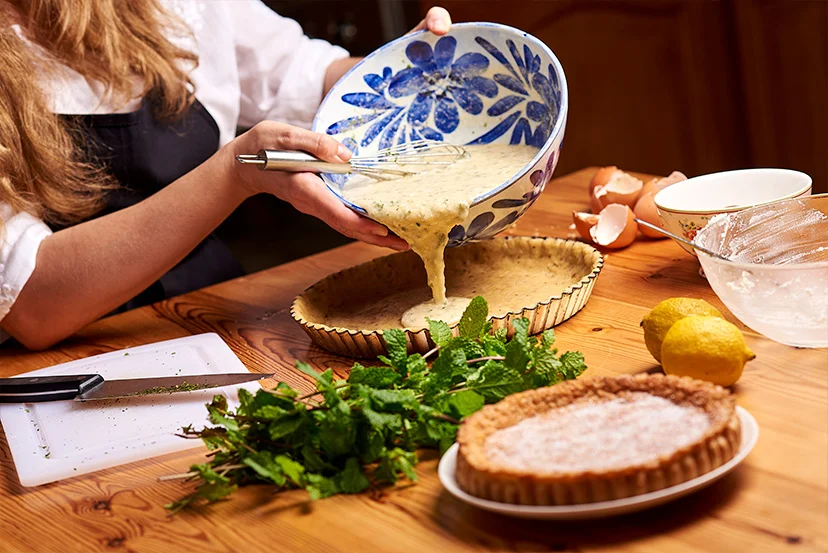The secret to obtaining a delicious Ibizan flaó, is a tasty combination fresh goat and sheep cheese and a good quantity of spearmint. This centuries-old dessert, is a gastronomic gem and pride of the Ibicencos. It delights all who taste it.
The first documented mention of the current version of the flan dates back to the 13th century book ‘Blanquerna’ by Ramón Llull. In his work, the famous writer and philosopher says, «Li donà un flaó que menjàs en l’escola si li venia sabor de menjar», which roughly means, «I give you a flaó to eat at school in case you feel hungry». This reference suggests that that flaó was already a recognised food and appreciated in this era.

Nevertheless, it could have appeared even earlier, specifically in the Roman Age. In the book ‘De Re Coquinaria’ by Apicius, an ancient recipe book mentions a dish known as tyropatinam. The Ibizan researcher Joan Serra says there is no consensus on the publication date of this cookery book, but it could be dated between the 1st and 5th centuries.
The etymology of the word tyropatinam is not too clear, Serra adds, but it could be a combination of ‘tyro’, meaning cheese in Greek, and ‘patinam’, Latin for bowl. Although it could be interpreted as a primitive flaó, the reality is that it is more similar to the current flan and the name could merely refer to the appearance of fresh cheese of this dessert.
Evolution of the flaó
During the 7th century, the recipe for tyropatinam evolved giving rise to the current flan (baked custard) and other similar desserts, including the ibicenca one. The current word ‘flaó’ derives from the ancient French ‘fladó’.

The 15th century book ‘Llibre del Coch’ by Catalan Mestre Robert contains a flaó recipe that describes a hand made dough, without a mould, made with flour and water. A filling is added to this preparation with ingredients such as fresh cheese and curd cheese, spearmint and eggs. Once cooked, rose water and honey or sugar syrup was drizzled over it until it was absorbed and then sprinkled with sugar and cinnamon.
The recipe for medieval flaó is quite similar to the modern one. The main difference lies in the size; although it is currently a dessert of fairly large proportions, centuries ago they were individual tartlets, the size of a palm. Proof of this can be found in the fact that Llull in ‘Blanquerna’ cites that a child carried it to school, or that there is always talk of «batches» of flaones.
The flaó in the Balearics
There are many different interpretations of Flaó on the island. In Mallorca, flaons were a type of pasty, but without a lid, filled with curd cheese, eggs, lemon zest and sugar, although they are no longer made today. In Menorca, they are still preserved, but they are half-moon shaped. They are prepared with a small amount of circular pastry and filled with curd cheese on one half and are covered on the other.

In Ibiza, the flaó arrived with the Catalan conquest in the medieval era. It was a popular dessert eaten during Lent, as it didn’t contain any meat and also coincided with the cheese producing season. What distinguishes the Ibizan flaó from other similar patsries found in the Mediterranean arc is the presence of spearmint in the filling, one of the many mints present in the Ibizan gardens, and that gives it that unique touch of authenticity which is so appreciated.
Serra points out that Ibiza’s isolation over the centuries has allowed the preservation of “authentic culinary fossils” such as flaó or salsa de Nadal (Christmas sauce).
As occurs in all dishes of traditional Ibizan cuisine, there is no single and true recipe of flaó but there are many households that safeguard their own recipe and whose secrets have been passed down from generation to generation. The quality, texture and humidity of the cheese used in each tart will mark the final result of the dessert.
Recipe for the Ibizan flaó
To prepare an authentic Ibizan flaó, specific ingredients and a careful process are needed. The ingredients for the dough include flour, lemon zest, sugar, egg, salt, sweet anise, anisette, extra virgin olive oil and lard. For the filling, eggs, sugar, fresh goat and sheep cheese, and spearmint are used.

First, mix the flour with the lemon zest, sugar, egg, salt, sweet anise and anisette. Then add the olive oil and lard until obtaining a homogeneous dough. Leave it to rest and beat the eggs with the sugar, add the crumbled fresh cheese and the chopped spearmint for the filling. Then, spread the dough, place in a mould and fill it with the mixture of cheese and spearmint. Finally, bake at a medium temperature until the surface is golden and the filling is set.
In addition to an exquisite dessert, the Ibizan flaó is also a symbol of the island’s rich history and culture. Enjoying a flaó is a way to savour the essence of Ibiza, an island where tradition and modernity are intertwined in perfect harmony.








